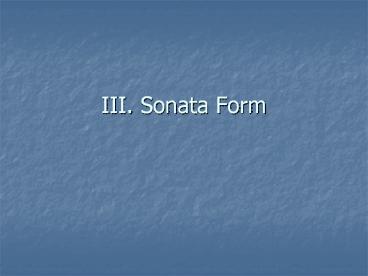III. Sonata Form - PowerPoint PPT Presentation
1 / 23
Title:
III. Sonata Form
Description:
III. Sonata Form III. Sonata Form Sometimes called sonata-allegro form Definition- The form of a single movement. Do not confuse with the term sonata- used for a ... – PowerPoint PPT presentation
Number of Views:193
Avg rating:3.0/5.0
Title: III. Sonata Form
1
III. Sonata Form
2
III. Sonata Form
- Sometimes called sonata-allegro form
- Definition- The form of a single movement.
- Do not confuse with the term sonata- used for a
whole composition made up of several movements.
3
The form consists of 3 main sections
- Exposition- themes are presented
- Usually labeled with the letters A B
- Development- themes are treated in new ways
- Usually labeled with the letter C
- Recapitulation- themes return
- Letters A B or sometimes A B
- These sections are often followed by a concluding
section- the coda (Italian for tail)
4
C MozartT Symphony No. 40 in G Minor, IV Mt.
- D 1788
- S String Orchestra
- H G minor
- M A- Fast Rushing Notes, B- Tender sweet melody
- R Duple 2/2
- F Sonata Form
- T Polyphonic
5
IV. Theme Variations
6
IV. Theme Variations
- Definition- a basic musical idea- the theme- is
repeated over and over and is changed each time. - Widely used during this period.
- Each variation is about the same length, however
it is unique and may differ in mood. - Changes in melody, rhythm, harmony,
accompaniment, dynamics, or tone color may be
used for change
7
C HaydnT Symphony No. 94 in G Major, II Mt.
- D 1791
- S Woodwinds, Brass, Perc, Strings
- H G Major
- M Surprise Staccatoed melody
- R Duple 2/4
- F Theme Variations
- T Polyphonic
8
V. Minuet Trio
9
V. Minuet Trio
- Sometimes simply referred to as Minuet.
- Often used as the third movement of classical
symphonies, string quartets, and other works. - Originated as a dance
- First appeared in the court of Louis XIV of
France around 1650 - Danced by aristocrats throughout the 18th Cent
- Stately, dignified dance for couples
10
Minuet for symphony
- This minuet is written for listening, not
dancing. - Written in triple meter ¾
- Usually a moderate tempo
- Form A (minuet), B (trio), A (minuet)
- Trio section is usually quieter than the minuet
and also requires fewer instruments - Structurally the simplest movement of a symphony
or string quartet
11
C MozartT Eine Kleine Nachtmusik (A little night
music) III Minuet
- D 1787
- S string serenade light in mood
- H G major
- M Stately melody moves to legato back to
stately - R Triple 3/4
- F ABA
- T Polyphonic
12
VI. Rondo
13
VI. Rondo
- Many Classical movements are in Rondo form
- Definition- features a tuneful main theme which
returns several times in alternation with other
themes. - Main theme- usually lively, pleasing, and simple
to remember. - Can be used either as an independent piece or as
one movement of a symphony, string quartet, or a
sonata
14
VI. Rondo
- Often is a finale, because of its liveliness
bringing a sense of conclusion - Rondo form is often combined with elements of
sonata form to produce a sonata-rondo - contains a development section like in sonata
form - Outlined in ABACABA
15
C BeethovenT String Quartet in C minor Op18, No.
4 IV Mvt. Rondo
- D 1798-1800
- S String Quartet
- H A Section C minor B and C Sections Major
- M Lively Fast violin Lyrical Legato Melody
- R Duple 2/2
- F ABACABA
- T Polyphonic
16
VII. The Classical Symphony
17
The Classical Symphony
- Definition- an extended, ambitious composition
typically lasting between 20 and 45 minutes. It
exploits and expands the range of tone color and
dynamics of the classical orchestra.
18
Usually has 4 movements
- Each movement evokes a wide range of musicians
- Typical sequence of movements
- 1) vigorous, dramatic fast movement
- 2) lyrical slow movement
- 3) dance-like (minuet or scherzo)
- 4) brilliant or heroic, fast movement
19
The Classical Symphony
- Opening movement almost always is fast and in
sonata form, usually the most dramatic - Second- slow movement- broad song-like melodies
- Third- generally a minuet and trio, or scherzo
- Fourth- often in sonata or sonata-rondo form,
usually fast, lively, or triumphant depending on
the composer
20
VIII. The Classical Concerto
21
The Classical Concerto
- Definition- three movement work for an
instrumental soloist and orchestra - Combines virtuosic solo passages with orchestras
wide range of tone color and dynamics - Lasts from 20-45 minutes!
22
Three movement work
- 1) Fast 2) Slow 3) Fast
- No minuet or scherzo
- Often will have a cadenza at the end where
orchestra holds chord while soloist does a
virtuosic passage
23
C HaydnT Trumpet Concerto in Eb Major III Mvt
Allegro
- D 1796
- S Solo Trumpet, Woodwinds, Timpani, Strings
- H Eb Major
- M Soft legato string, virtuoso trumpet
- R duple 2/4
- F Sonata-Rondo (ABA BACABCoda)
- T Homophonic































